The Agricultural Potential of a Region with Semi-Dry, Warm and Temperate Subhumid Climate Diversity through Agroecological Zoning
Abstract
:1. Introduction
2. Materials and Methods
2.1. Study Area and Geospatial Data
2.2. Interpolation of Climatic Variables and Soil Properties
2.3. Description of Agroclimatic Zoning
2.4. Agroecological Zoning (Modified GAEZ)
2.5. Zoning with the ECOCROP Method
2.6. Agroclimatic Zoning Using the Papadakis Method
2.7. The Edaphoclimatic Suitability of Crops
3. Results
3.1. Weather Stations, Sampling Sites and Crops
3.2. Zoning Using the GAEZ Method
3.3. Zoning Using the ECOCROP Method
3.4. Zoning Using the Papadakis Method
3.5. Edaphic Suitability
3.6. Field Check
3.7. The Edaphoclimatic Suitability of Crops
4. Discussion
5. Conclusions
Author Contributions
Funding
Institutional Review Board Statement
Informed Consent Statement
Data Availability Statement
Acknowledgments
Conflicts of Interest
References
- Gupta, R.; Mishra, A. Climate Change Induced Impact and Uncertainty of Rice Yield of Agro-Ecological Zones of India. Agric. Syst. 2019, 173, 1–11. [Google Scholar] [CrossRef]
- Deutsch, C.A.; Tewksbury, J.J.; Tigchelaar, M.; Battisti, D.S.; Merrill, S.C.; Huey, R.B.; Naylor, R.L. Increase in Crop Losses to Insect Pests in a Warming Climate. Science 2018, 361, 916–919. [Google Scholar] [CrossRef] [PubMed] [Green Version]
- Pohanková, E.; Hlavinka, P.; Kersebaum, K.C.; Rodríguez, A.; Balek, J.; Bednařík, M.; Dubrovský, M.; Gobin, A.; Hoogenboom, G.; Moriondo, M.; et al. Expected Effects of Climate Change on the Production and Water Use of Crop Rotation Management Reproduced by Crop Model Ensemble for Czech Republic Sites. Eur. J. Agron. 2022, 134, 126446. [Google Scholar] [CrossRef]
- Rafiei-Sardooi, E.; Azareh, A.; Joorabian Shooshtari, S.; Parteli, E.J.R. Long-Term Assessment of Land-Use and Climate Change on Water Scarcity in an Arid Basin in Iran. Ecol. Model. 2022, 467, 109934. [Google Scholar] [CrossRef]
- Chang, K.; Ying, Y.H. External Benefits of Preserving Agricultural Land: Taiwan’s Rice Fields. Soc. Sci. J. 2005, 42, 285–293. [Google Scholar] [CrossRef]
- Lobell, D.B. The Use of Satellite Data for Crop Yield Gap Analysis. Field Crops Res. 2013, 143, 56–64. [Google Scholar] [CrossRef] [Green Version]
- Liu, Y.; Liu, L.; Zhu, A.X.; Lao, C.; Hu, G.; Hu, Y. Scenario Farmland Protection Zoning Based on Production Potential: A Case Study in China. Land Use Policy 2020, 95, 104581. [Google Scholar] [CrossRef]
- Wallace, J.S. Increasing Agricultural Water Use Efficiency to Meet Future Food Production. Agric. Ecosyst. Environ. 2000, 82, 105–119. [Google Scholar] [CrossRef]
- FAO. Report on the Agro-Ecological Zones Project; Methodology and Results for Africa; FAO: Rome, Italy, 1978; Volume 1, p. 158. [Google Scholar]
- Kassam, A.H. The Agro-Ecological Zones Project. ESA Spec. Publ. 1979, 1020, 32–33. [Google Scholar]
- Higgins, G.M.; Kassam, A.H. The FAO Agro-Ecological Zone Approach to Determination of Land Potential. Pedologie 1981, 2, 147–168. [Google Scholar]
- Van Wart, J.; van Bussel, L.G.J.; Wolf, J.; Licker, R.; Grassini, P.; Nelson, A.; Boogaard, H.; Gerber, J.; Mueller, N.D.; Claessens, L.; et al. Use of Agro-Climatic Zones to Upscale Simulated Crop Yield Potential. Field Crops Res. 2013, 143, 44–55. [Google Scholar] [CrossRef] [Green Version]
- FAO. AEZ in Asia Proceedings of the Regional Workshop on Agro-Ecological Zones Methodology and Aplications, 1st ed.; Agriculture Organization of the United Nations: Bangkok, Thailand, 1994; ISBN 92-5-103457-5. [Google Scholar]
- Ortíz Solorio, C.A. Evaluation of Mexican Land for Corn, Bean and Sorghum Production under Rainfed Conditions; Serie Cuadernos de Edafología 8; Centro de Edafología: Chapingo, Mexico, 1987; pp. 1–40. [Google Scholar]
- Peter, B.G.; Messina, J.P.; Lin, Z.; Snapp, S.S. Crop Climate Suitability Mapping on the Cloud: A Geovisualization Application for Sustainable Agriculture. Sci. Rep. 2020, 10, 1–17. [Google Scholar] [CrossRef]
- Fischer, G.; Nachtergaele, F.O.; Prieler, S.; Teixeira, E.; Tóth, G.; Van Velthuizen, H.; Wiberg, D. Global Agro-Ecological Zone V3—Model Documentation, 2nd ed.; International Institute for Applied Systems Analysis (IIASA): Laxenburg, Austria; Food and Agriculture Organization of the United Nations (FAO): Rome, Italy, 2012; Volume V3. [Google Scholar]
- Fischer, G.; Sun, L. Model Based Analysis of Future Land-Use Development in China. Agric. Ecosyst. Environ. 2001, 85, 163–176. [Google Scholar] [CrossRef]
- Dutta, S.; Rahman, S.; Rahman, H.; Sharifee, N.H.; Sultana, N. Pertinence of FAO Land Evaluation Model for Optimum Agricultural Land Use Planning Using Remote Sensing and GIS. Sci. Soc. Adv. Res. Soc. Chang. SSARSC Int. J. ICT 2020, 2, 10–21. [Google Scholar]
- Deng, N.; Grassini, P.; Yang, H.; Huang, J.; Cassman, K.G.; Peng, S. Closing Yield Gaps for Rice Self-Sufficiency in China. Nat. Commun. 2019, 10, 1–9. [Google Scholar] [CrossRef] [Green Version]
- Van Wart, J.; Kersebaum, K.C.; Peng, S.; Milner, M.; Cassman, K.G. Estimating Crop Yield Potential at Regional to National Scales. Field Crops Res. 2013, 143, 34–43. [Google Scholar] [CrossRef] [Green Version]
- Fischer, G.; van Velthuizen, H.; Nachtergaele, F.O.; Jernelöv, A. Global Agro-Ecological Zones Assessment: Methodology and Results; IIASA: Laxenburg, Austria; FAO: Rome, Italy, 2000; p. 338. [Google Scholar]
- Akpoti, K.; Kabo-bah, A.T.; Zwart, S.J. Agricultural Land Suitability Analysis: State-of-the-Art and Outlooks for Integration of Climate Change Analysis. Agric. Syst. 2019, 173, 172–208. [Google Scholar] [CrossRef]
- Jiménez Córdova, A.; Vargas Tristán, V.; Salinas Castillo, W.E.; Aguirre Borton, M.d.J.; Rodríguez Cabrera, D. Agroecological Suitability for the Sugarcane Crop in Southern Tamaulipas, Mexico. Investig. Geogr. 2004, 53, 58–74. [Google Scholar]
- Reid, R.; Ryan, D.M.; Burt, R.L. Exploration for, and Utilization of, Collections of Tropical Pasture Legumes II. The Papadakis System of Climatic Classification Applied to Testing Areas in Northern Australia. Agro-Ecosyst. 1976, 2, 309–318. [Google Scholar] [CrossRef]
- Montsant, A.; Baena, O.; Bernárdez, L.; Puig, J. Modelling the Impacts of Climate Change on Potential Cultivation Area and Water Deficit in Five Mediterranean Crops. Span. J. Agric. Res. 2021, 19, 14. [Google Scholar] [CrossRef]
- Coelho, J.C.; Pinto, P.A. Brief Characterization And Analysis Of Soils And Climate And An Analysis Of Suitability To Irrigation Of The Portuguese Continental Territory. Int. J. Agric. Environ. Sci. 2019, 6, 86–95. [Google Scholar] [CrossRef]
- Arshad, A.M.; Rawayau, H.Y. Climatic Classification for Agricultural Potential in Peninsular Malaysia. J. Biol. Agric. Healthc. 2016, 6, 5–13. [Google Scholar]
- Moghtaderi, G.; Khorramdel, F. Evaluation of Climatic Agricultural Potentials of Fars Province Using Papadakis Technique. Indian J. Fundam. Appl. Life Sci. 2014, 4, 60–70. [Google Scholar]
- Velasco, I.; Pimentel, E. Papadakis Methodology for Agroclimatic Delimitation, Applied to Sinaloa State, Mexico. Investig. Geogr. 2010, 73, 86–102. [Google Scholar]
- Mendoza-Cariño, M.; Bautista-Olivas, A.L.; Mendoza-Cariño, D.; Ortiz-Solorio, C.A.; Duarte-Tagles, H.; Cruz-Flores, G. Agroclimatic Zoning of the State of Nayarit, Mexico. Atmosfera 2023, 36, 123–142. [Google Scholar] [CrossRef]
- Silvar, C.; Casas, A.M.; Kopahnke, D.; Habekuß, A.; Schweizer, G.; Gracia, M.P.; Lasa, J.M.; Ciudad, F.J.; Molina-Cano, J.L.; Igartua, E.; et al. Screening the Spanish Barley Core Collection for Disease Resistance. Plant Breed. 2010, 129, 45–52. [Google Scholar] [CrossRef] [Green Version]
- Hijmans, R.J.; Guarino, L.; Cruz, M.; Rojas, E. Computer Tools for Spatial Analysis of Plant Genetic Resources Data: 1. DIVA-GIS. Plant Genet. Resour. Newsl. 2001, 127, 15–19. [Google Scholar]
- Fick, S.E.; Hijmans, R.J. WorldClim 2: New 1-Km Spatial Resolution Climate Surfaces for Global Land Areas. Int. J. Climatol. 2017, 37, 4302–4315. [Google Scholar] [CrossRef]
- Hijmans, R.J.; Cameron, S.E.; Parra, J.L.; Jones, P.G.; Jarvis, A. Very High Resolution Interpolated Climate Surfaces for Global Land Areas. Int. J. Climatol. 2005, 25, 1965–1978. [Google Scholar] [CrossRef]
- Manners, R.; van Etten, J. Are Agricultural Researchers Working on the Right Crops to Enable Food and Nutrition Security under Future Climates? Glob. Environ. Chang. 2018, 53, 182–194. [Google Scholar] [CrossRef]
- Palacios Romero, A.; Rodríguez Laguna, R.; Hernández Flores, M.d.l.L. Distribución Potencial de Prosopis Laevigata (Humb. et Bonpl. Ex Willd) M. C. Johnston Basada En Un Modelo de Nicho Ecológico. Rev. Mex. Cienc. For. 2017, 7, 035–046. [Google Scholar] [CrossRef] [Green Version]
- Santillán-Fernández, A.; Vargas Cabrera, I.I.; Pelcastre Ruiz, L.M.; Carrillo Ávila, E.; Alatorre Cobos, F.; Bautista Ortega, J. Resilience of Vegetation Cover in Southwest Mexico to the Climate Change Effects. Rev. Peru. Biol. 2021, 28, e18187. [Google Scholar] [CrossRef]
- Jarvis, A.; Lane, A.; Hijmans, R.J. The Effect of Climate Change on Crop Wild Relatives. Agric. Ecosyst. Environ. 2008, 126, 13–23. [Google Scholar] [CrossRef]
- Gardner, A.S.; Gaston, K.J.; Maclean, I.M.D. Combining Qualitative and Quantitative Methodology to Assess Prospects for Novel Crops in a Warming Climate. Agric. Syst. 2021, 190, 103083. [Google Scholar] [CrossRef]
- Manners, R.; Varela-Ortega, C.; van Etten, J. Protein-Rich Legume and Pseudo-Cereal Crop Suitability under Present and Future European Climates. Eur. J. Agron. 2020, 113, 125974. [Google Scholar] [CrossRef]
- Jones, J.W.; Antle, J.M.; Basso, B.; Boote, K.J.; Conant, R.T.; Foster, I.; Godfray, H.C.J.; Herrero, M.; Howitt, R.E.; Janssen, S.; et al. Brief History of Agricultural Systems Modeling. Agric. Syst. 2016, 155, 240–254. [Google Scholar] [CrossRef]
- Manners, R.; Vandamme, E.; Adewopo, J.; Thornton, P.; Friedmann, M.; Carpentier, S.; Ezui, K.S.; Thiele, G. Suitability of Root, Tuber, and Banana Crops in Central Africa Can Be Favoured under Future Climates. Agric. Syst. 2021, 193, 103246. [Google Scholar] [CrossRef]
- Ramirez-Villegas, J.; Jarvis, A.; Läderach, P. Empirical Approaches for Assessing Impacts of Climate Change on Agriculture: The EcoCrop Model and a Case Study with Grain Sorghum. Agric. For. Meteorol. 2013, 170, 67–78. [Google Scholar] [CrossRef]
- Instituto Nacional de Estadística y Geografía. Statistical and Geographical Yearbook of Nuevo León; Instituto Nacional de Estadística y Geografía (México): Aguascalientes, Mexico, 2015; ISBN 978-607-739-666-6.
- Instituto Nacional de Estadística y Geografía—INEGI (Ed.) Physiographic Vectorial Dataset. National Continuum; Scale 1:1,000,000; Series I; Instituto Nacional de Estadística y Geografía (México): Aguascalientes, Mexico, 2001.
- Cavazos, T. Downscaling Large-Scale Circulation to Local Winter Rainfall in North-Eastern Mexico. Int. J. Climatol. 1997, 17, 1069–1082. [Google Scholar] [CrossRef]
- Instituto Nacional de Estadística y Geografía. Dictionary of Edafological Data Scale 1:250 000; INEGI: Aguascalientes, Mexico, 2017; ISBN 970-13-3680-1.
- Sikder, I.U. Knowledge-Based Spatial Decision Support Systems: An Assessment of Environmental Adaptability of Crops. Expert Syst. Appl. 2009, 36, 5341–5347. [Google Scholar] [CrossRef]
- Servicio Meteorológico Nacional, Normales Climáticas por Estado. Available online: https://smn.conagua.gob.mx/es/informacion-climatologica-por-estado?estado=nl (accessed on 7 January 2020).
- Secretaría de Medio Ambiente y Recursos Naturales, Norma Oficial Mexicana NOM-021-RECNAT-2000. Available online: https://dof.gob.mx/nota_detalle.php?codigo=717582&fecha=31/12/2002 (accessed on 12 December 2020).
- Villarreal Maces, S.G.; Díaz Viera, M.A. Geostatistical Estimation of the Spatial Distribution of Mean Monthly and Mean Annual Rainfall in Nuevo León, Mexico (1930–2014). Tecnol. Cienc. Agua 2018, 9, 106–127. [Google Scholar] [CrossRef]
- Chai, H.; Cheng, W.; Zhou, C.; Chen, X.; Ma, X.; Zhao, S. Analysis and Comparison of Spatial Interpolation Methods for Temperature Data in Xinjiang Uygur Autonomous Region, China. Nat. Sci. 2011, 3, 999–1010. [Google Scholar] [CrossRef] [Green Version]
- Kurtzman, D.; Kadmon, R. Mapping of Temperature Variables in Israel: A Comparison of Different Interpolation Methods. Clim. Res. 1999, 13, 33–43. [Google Scholar] [CrossRef] [Green Version]
- Campos Mantovanelli, B.; Petry, M.T.; Broetto Weiler, E.; Carlesso, R. Geostatistical Interpolation Based Ternary Diagrams for Estimating Water Retention Properties in Soils in the Center-South Regions of Brazil. Soil Tillage Res. 2021, 209, 104973. [Google Scholar] [CrossRef]
- Shahriari, M.; Delbari, M.; Afrasiab, P.; Pahlavan-Rad, M.R. Predicting Regional Spatial Distribution of Soil Texture in Floodplains Using Remote Sensing Data: A Case of Southeastern Iran. Catena 2019, 182, 104149. [Google Scholar] [CrossRef]
- Hijmans, R.J.; Guarino, L.; Mathur, P. DIVA-GIS Version 7.5 Manual. Available online: https://www.diva-gis.org/docs/DIVA-GIS_manual_7.pdf (accessed on 17 June 2020).
- Ortíz Solorio, C.A. (Ed.) Elements of Quantitative Agrometerology with Applications in the Mexican Republic; Chapingo (México): Texcoco, Mexico, 2015. [Google Scholar]
- Sun, T.; Guo, J.; Ou, M. Assessing Grain Productivity Coupled with Farmers’ Behaviors Based on the Agro-Ecological Zones (AEZ) Model. Land 2022, 11, 1149. [Google Scholar] [CrossRef]
- Amin, M.E.S.; Mohamed, E.S.; Belal, A.A.; Jalhoum, M.E.M.; Abdellatif, M.A.; Nady, D.; Ali, A.M.; Mahmoud, A.G. Developing Spatial Model to Assess Agro-Ecological Zones for Sustainable Agriculture Development in MENA Region: Case Study Northern Western Coast, Egypt. Egypt. J. Remote Sens. Space Sci. 2022, 25, 301–311. [Google Scholar] [CrossRef]
- Ramírez Gómez, G.A.; Gutiérrez Castorena, E.V.; Ortíz Solorio, C.A.; del Carmen Gutiérrez Castorena, M. Crop Prediction and Diversification for Nuevo León, Mexico. Rev. Mex. Cienc. Agríc. 2020, 11, 1017–1030. [Google Scholar] [CrossRef]
- Laux, P.; Rötter, R.P.; Webber, H.; Dieng, D.; Rahimi, J.; Wei, J.; Faye, B.; Srivastava, A.K.; Bliefernicht, J.; Adeyeri, O.; et al. To Bias Correct or Not to Bias Correct? An Agricultural Impact Modelers’ Perspective on Regional Climate Model Data. Agric. For. Meteorol. 2021, 304–305, 108406. [Google Scholar] [CrossRef]

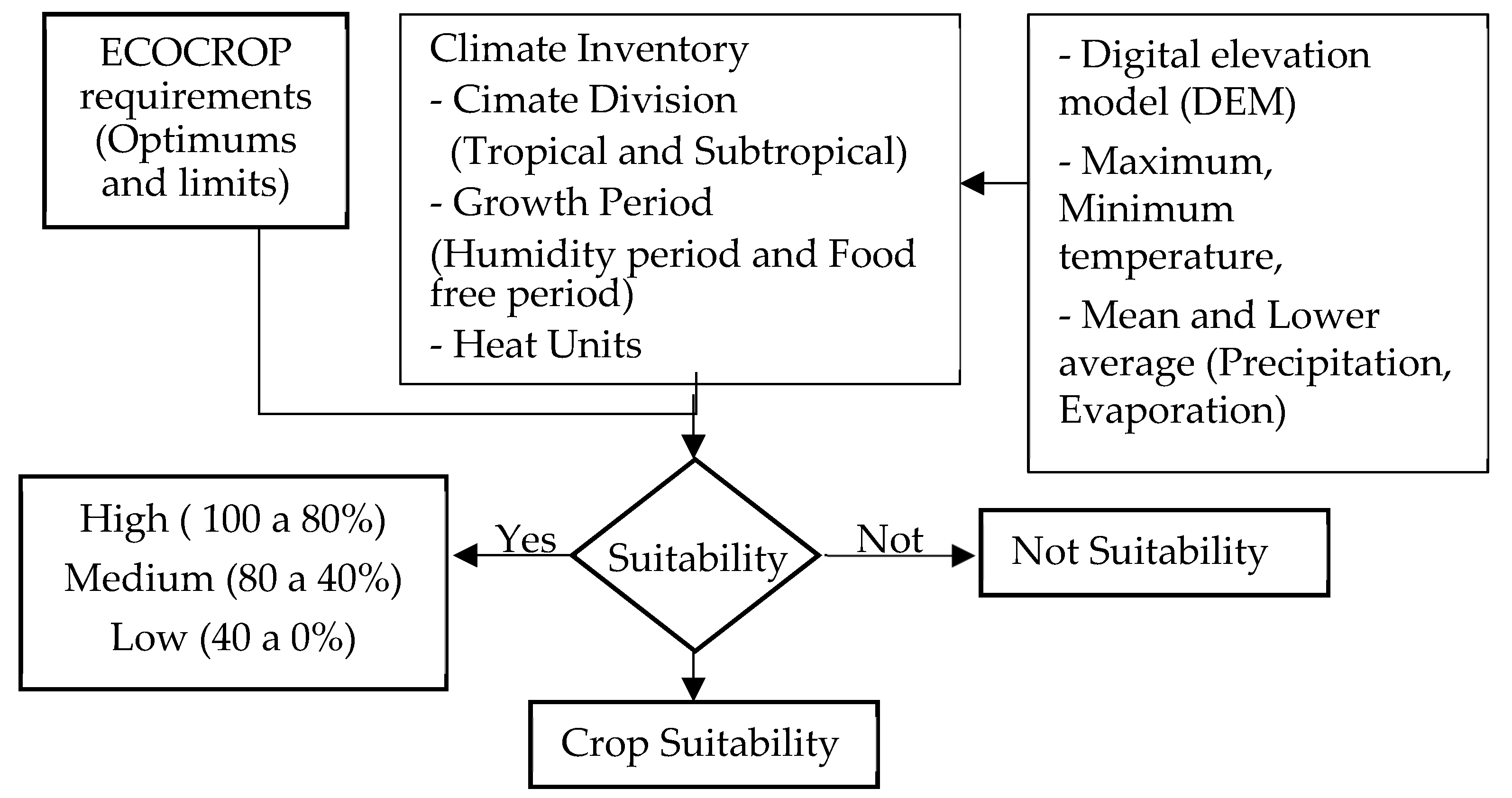


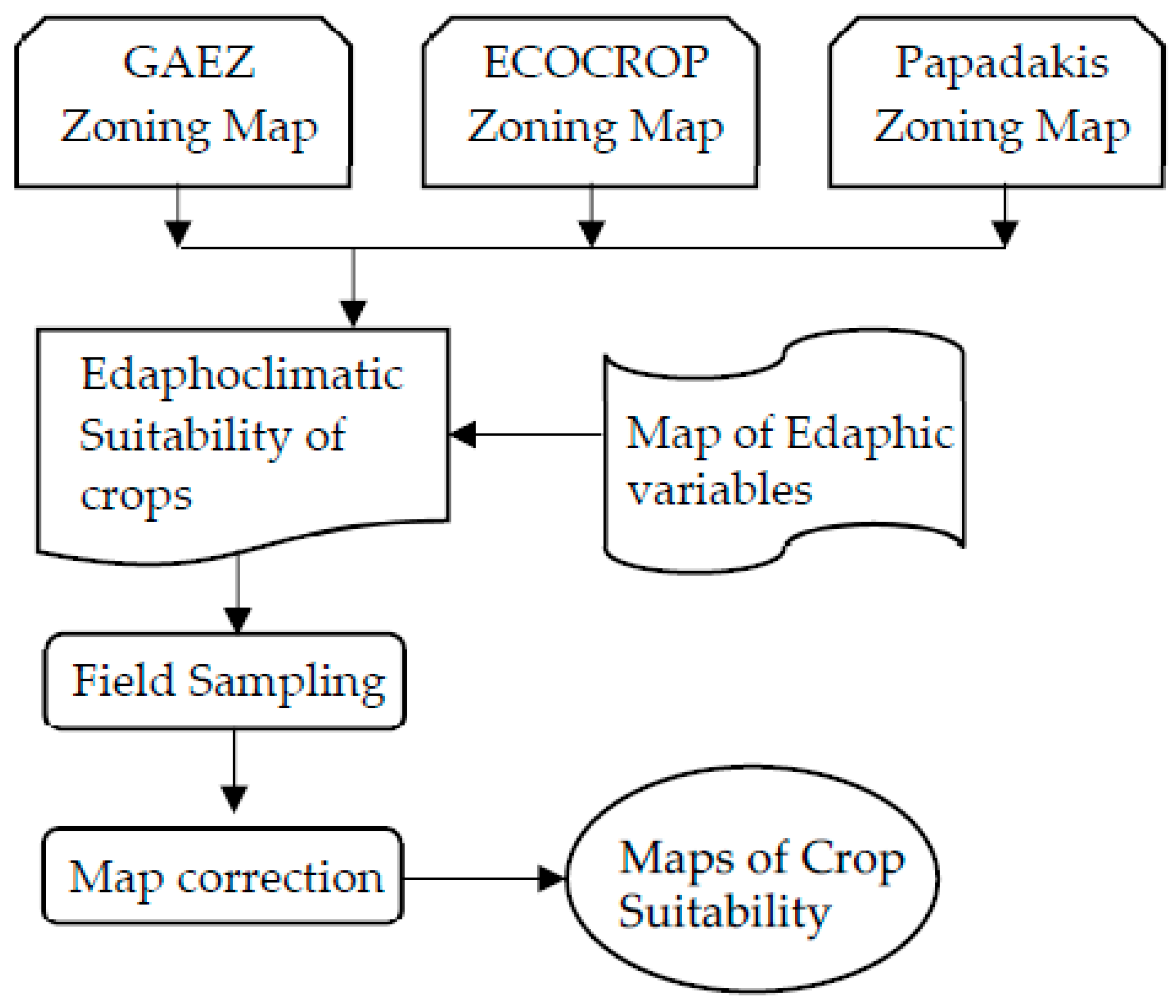


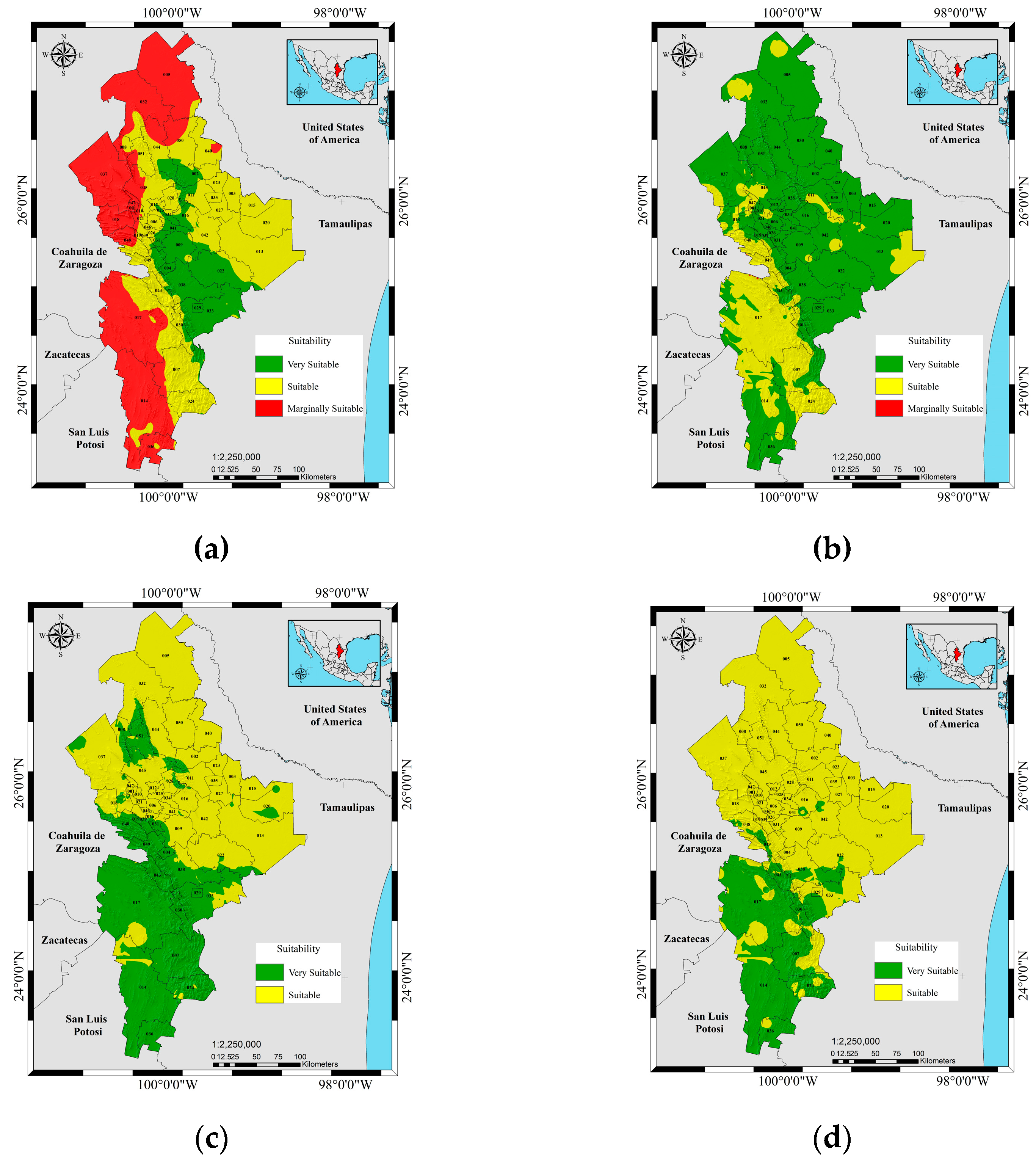

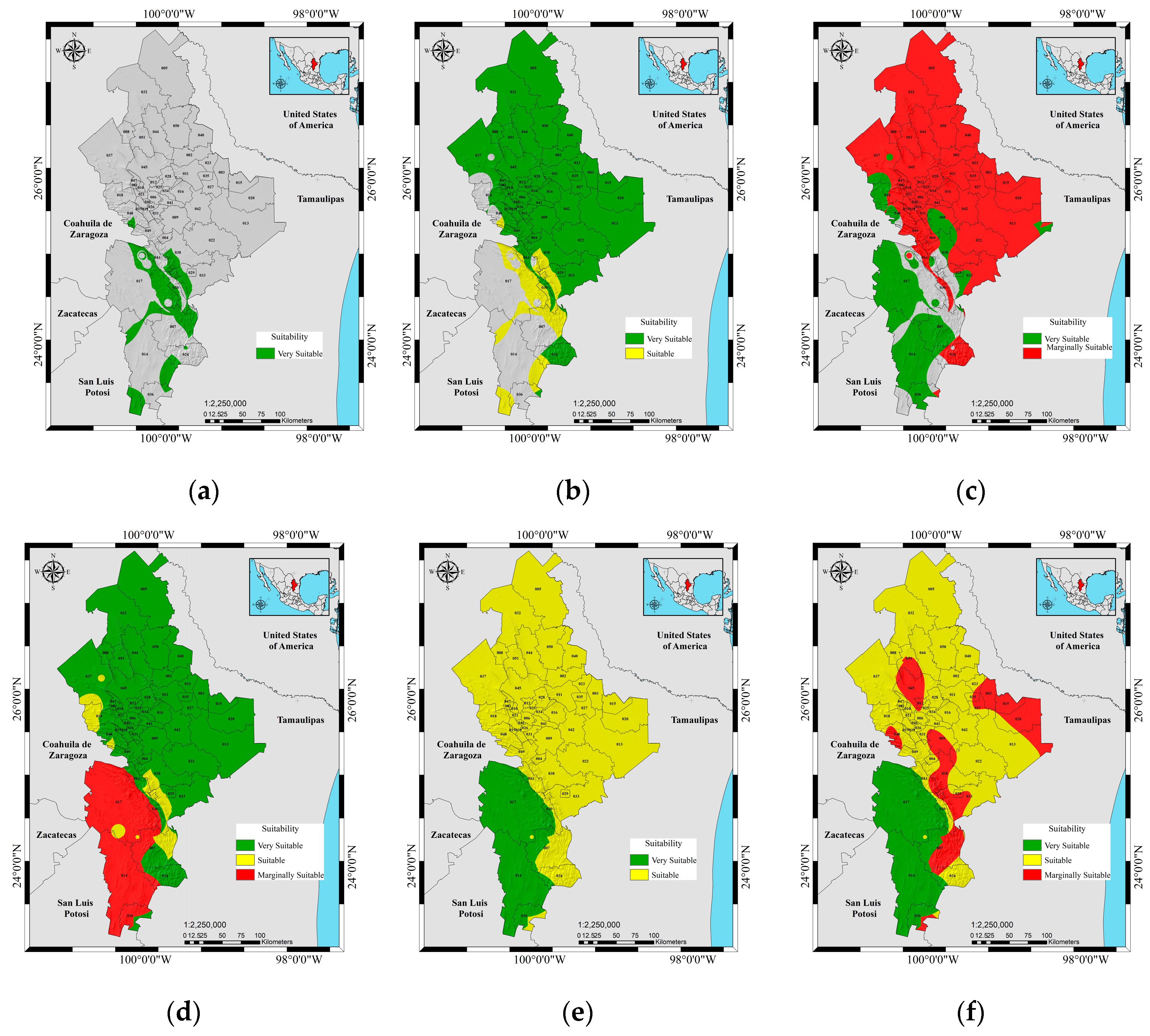
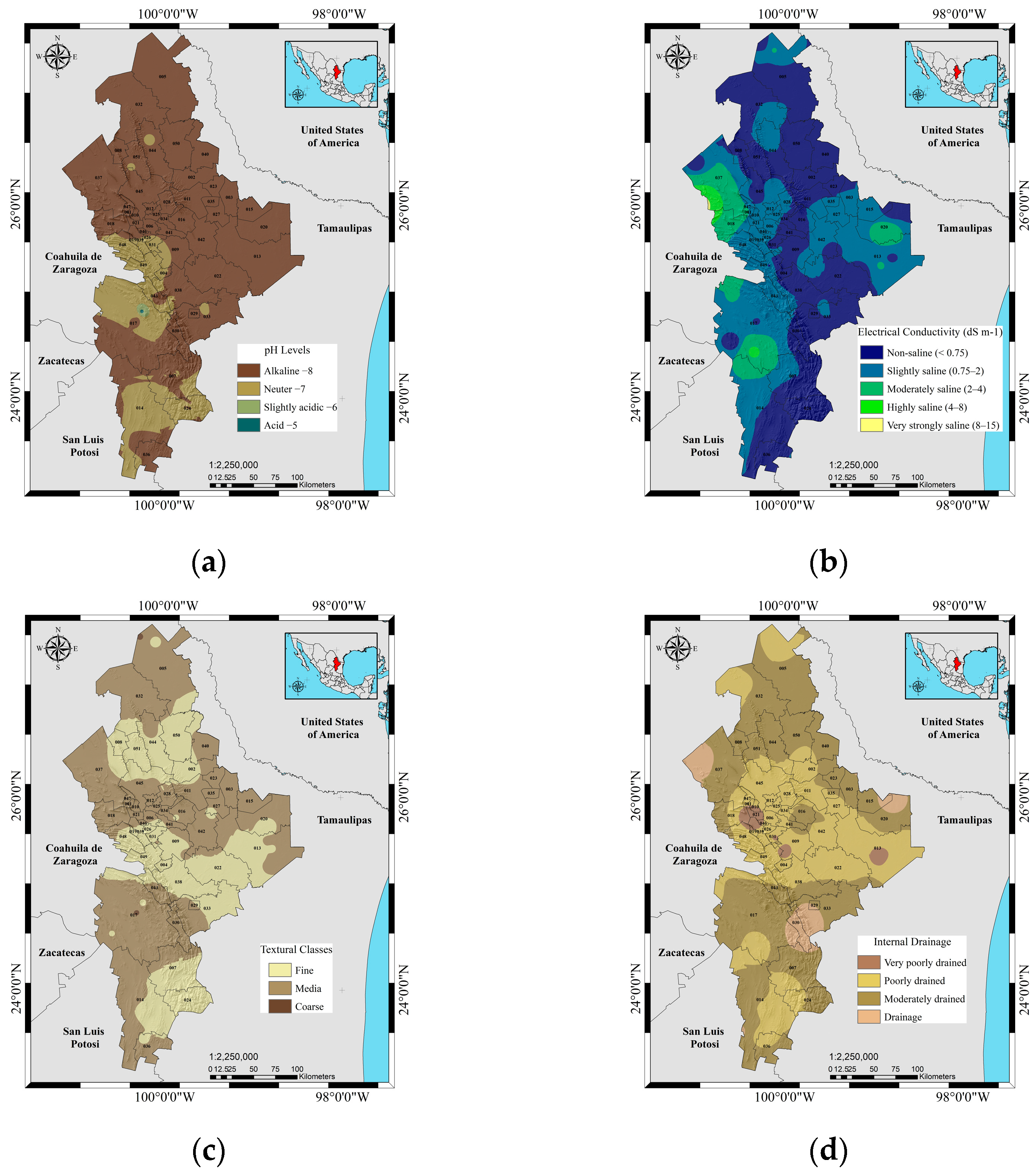

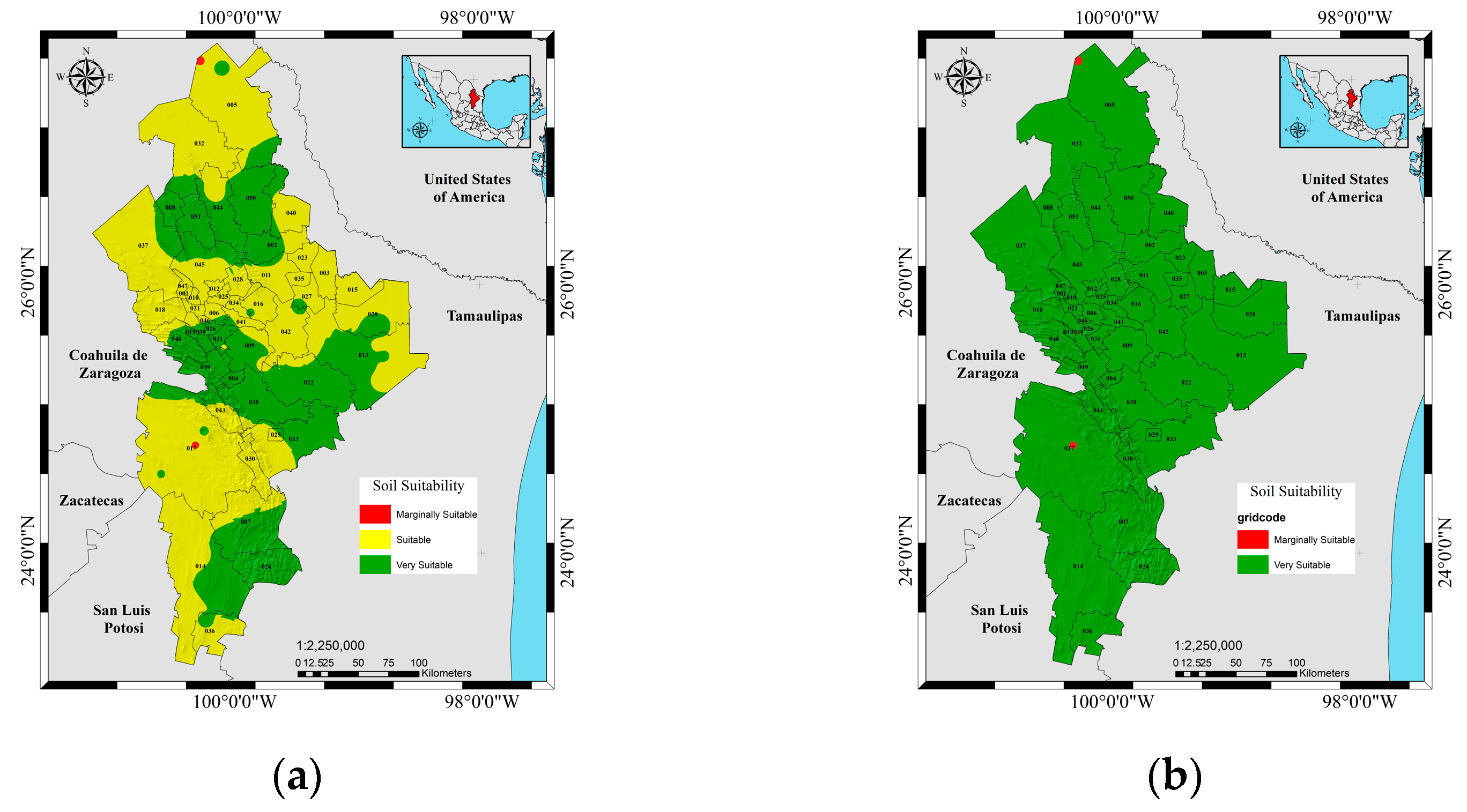
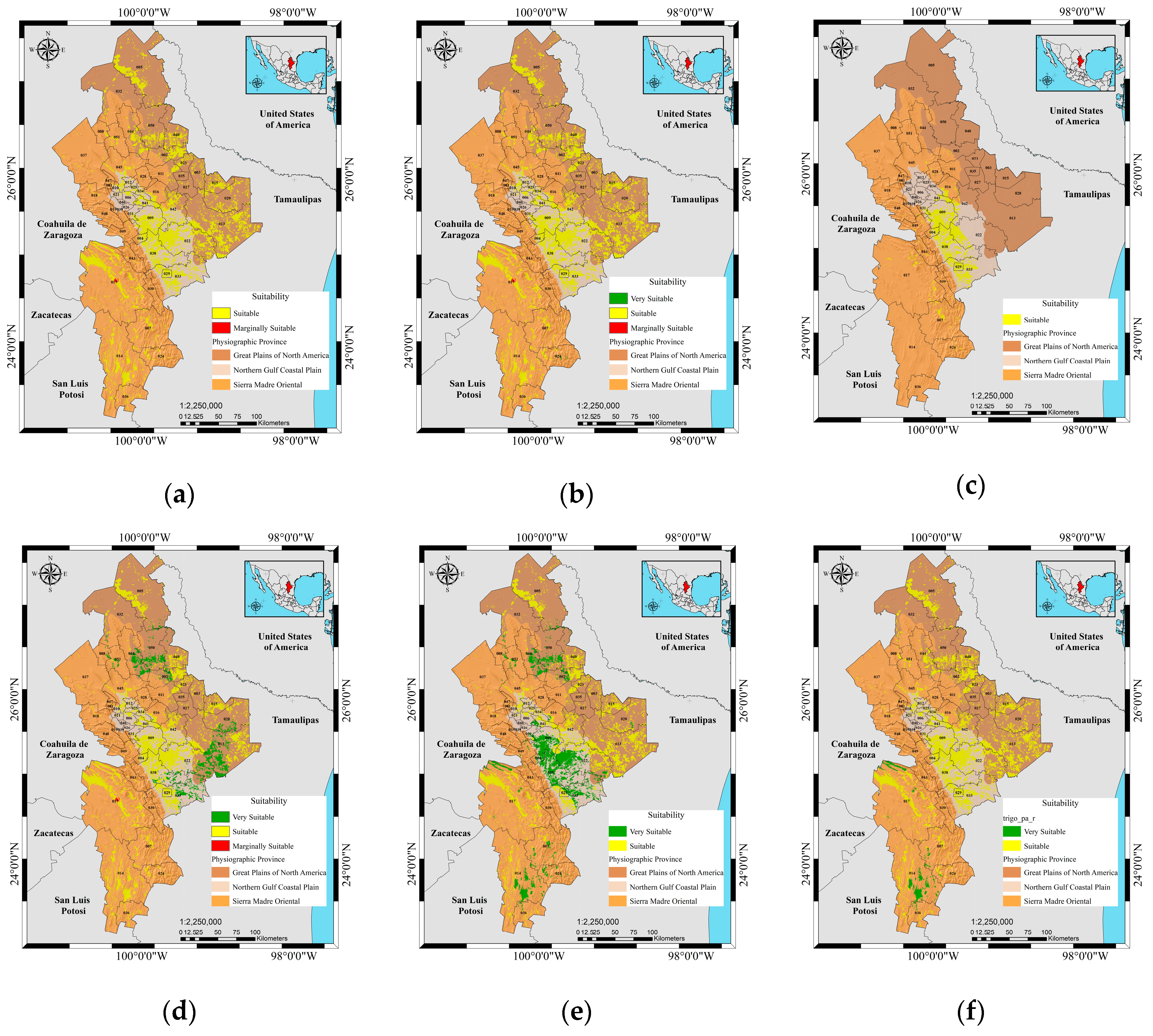
| Crop | By Municipality (Code) | Dryland Suitability (t ha −1) | Irrigation Suitability (t ha −1) | |||||
|---|---|---|---|---|---|---|---|---|
| Dryland | Irrigation | VS | S | Ma | VS | S | Ma | |
| Bean | 038 | 032 | 2–1.6 | 1.6–0.6 | 0.6–0.1 | 3–2.4 | 2.4–1 | 1–0.2 |
| Corn | 022 | 017 | 3–2.4 | 2.4–1 | 1–0.2 | 11–8.8 | 8.8–3.5 | 3.5–0.7 |
| Orange | 038 | 038 | 12–9.6 | 9.6–3.8 | 3.8–0.8 | 45–36 | 36–14.4 | 14.4–2.9 |
| Potato | N/A | 017 | N/A | 47–37.6 | 37.6–15 | 15–3 | ||
| Sorghum | 022 | 009 | 4–3.2 | 3.2–1.3 | 1.3–0.3 | 4–3.2 | 3.2–1.3 | 1.3–0.3 |
| Wheat | 022 | 017 | 5–4 | 4–1.6 | 1.6–0.3 | 5–4 | 4–1.6 | 1.6–0.3 |
| Crop | Irrigation | Dryland | ||||
|---|---|---|---|---|---|---|
| ECOCROP-R | GAEZ-R | PAPADAKIS | ECOCROP-S | GAEZ-S | PAPADAKIS | |
| Bean | 8 | 33 | N/A | 25 | 58 | N/A |
| Corn | 11 | 17 | 20 | 29 | 26 | 31 |
| Orange | 55 | 18 | 27 | 55 | 18 | 0 |
| Potato | 0 | 0 | 0 | 0 | 0 | 0 |
| Sorghum | 53 | 41 | 6 | 47 | 35 | 41 |
| Wheat | 68 | 28 | 24 | 12 | 8 | 0 |
Disclaimer/Publisher’s Note: The statements, opinions and data contained in all publications are solely those of the individual author(s) and contributor(s) and not of MDPI and/or the editor(s). MDPI and/or the editor(s) disclaim responsibility for any injury to people or property resulting from any ideas, methods, instructions or products referred to in the content. |
© 2023 by the authors. Licensee MDPI, Basel, Switzerland. This article is an open access article distributed under the terms and conditions of the Creative Commons Attribution (CC BY) license (https://creativecommons.org/licenses/by/4.0/).
Share and Cite
Castorena, E.V.G.; Gómez, G.A.R.; Solorio, C.A.O. The Agricultural Potential of a Region with Semi-Dry, Warm and Temperate Subhumid Climate Diversity through Agroecological Zoning. Sustainability 2023, 15, 9491. https://doi.org/10.3390/su15129491
Castorena EVG, Gómez GAR, Solorio CAO. The Agricultural Potential of a Region with Semi-Dry, Warm and Temperate Subhumid Climate Diversity through Agroecological Zoning. Sustainability. 2023; 15(12):9491. https://doi.org/10.3390/su15129491
Chicago/Turabian StyleCastorena, Edgar Vladimir Gutiérrez, Gustavo Andrés Ramírez Gómez, and Carlos Alberto Ortíz Solorio. 2023. "The Agricultural Potential of a Region with Semi-Dry, Warm and Temperate Subhumid Climate Diversity through Agroecological Zoning" Sustainability 15, no. 12: 9491. https://doi.org/10.3390/su15129491







